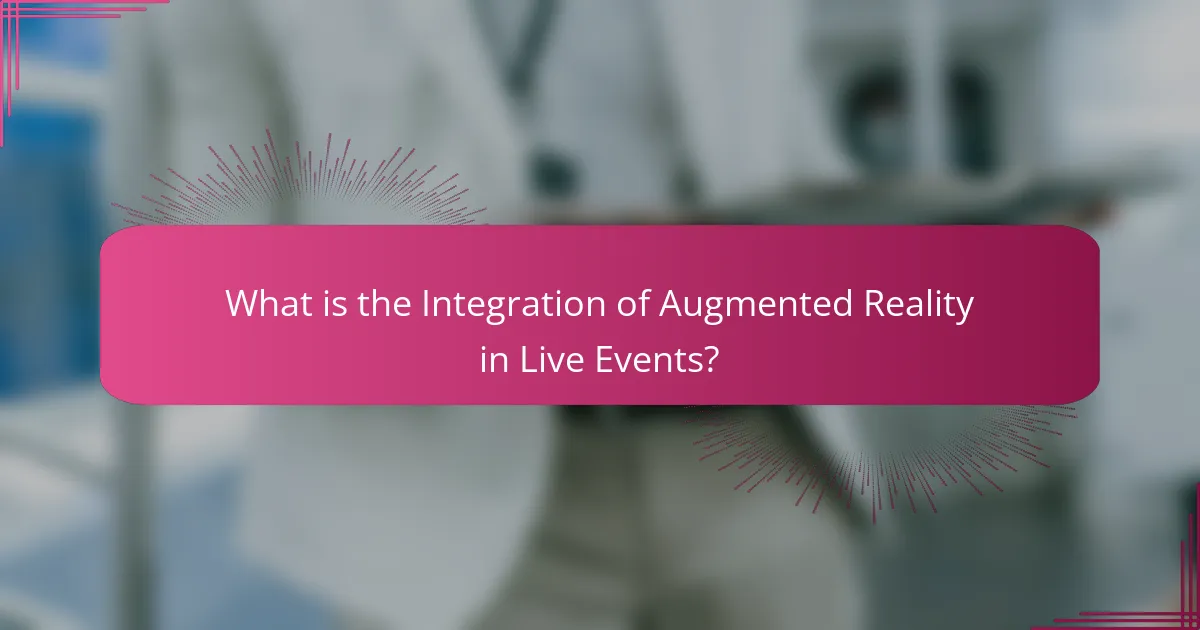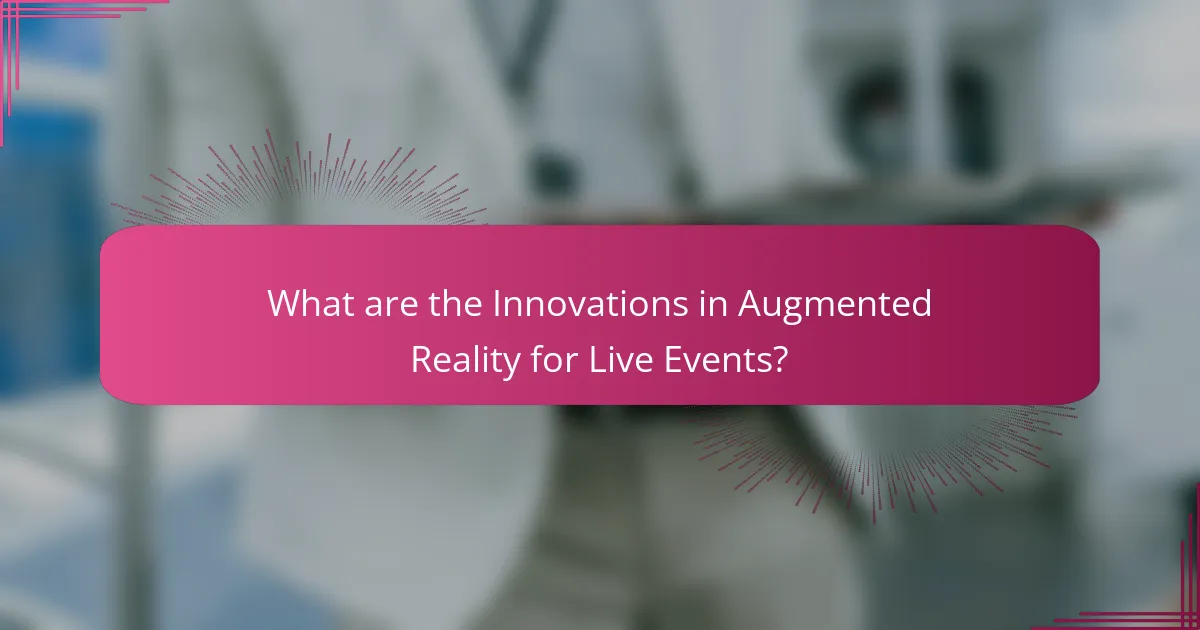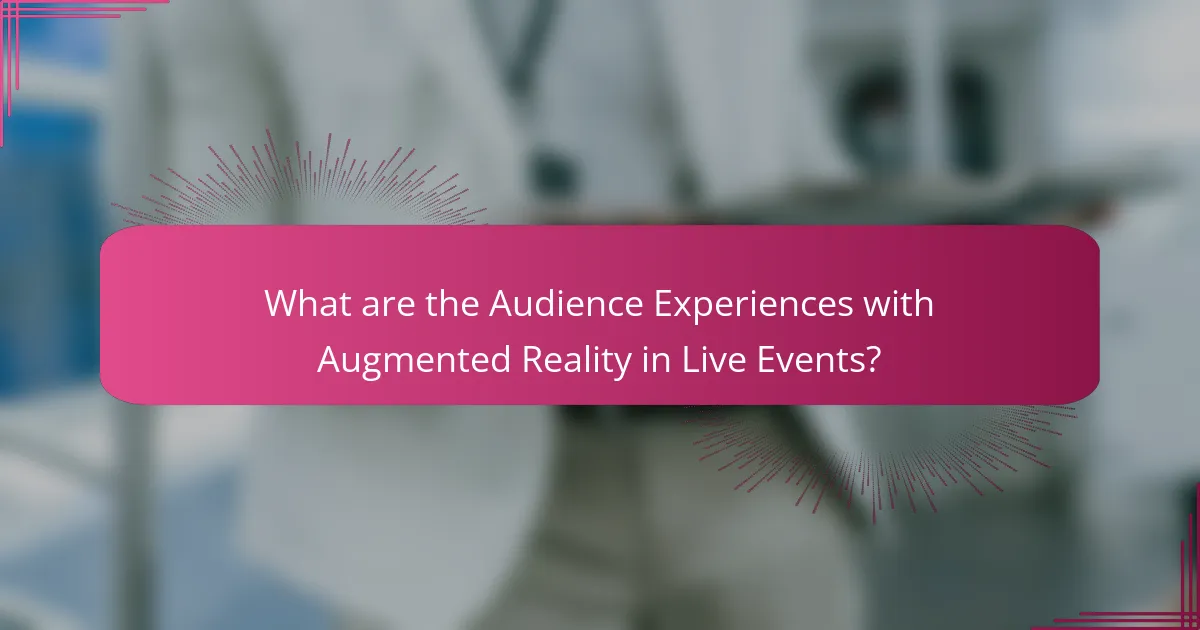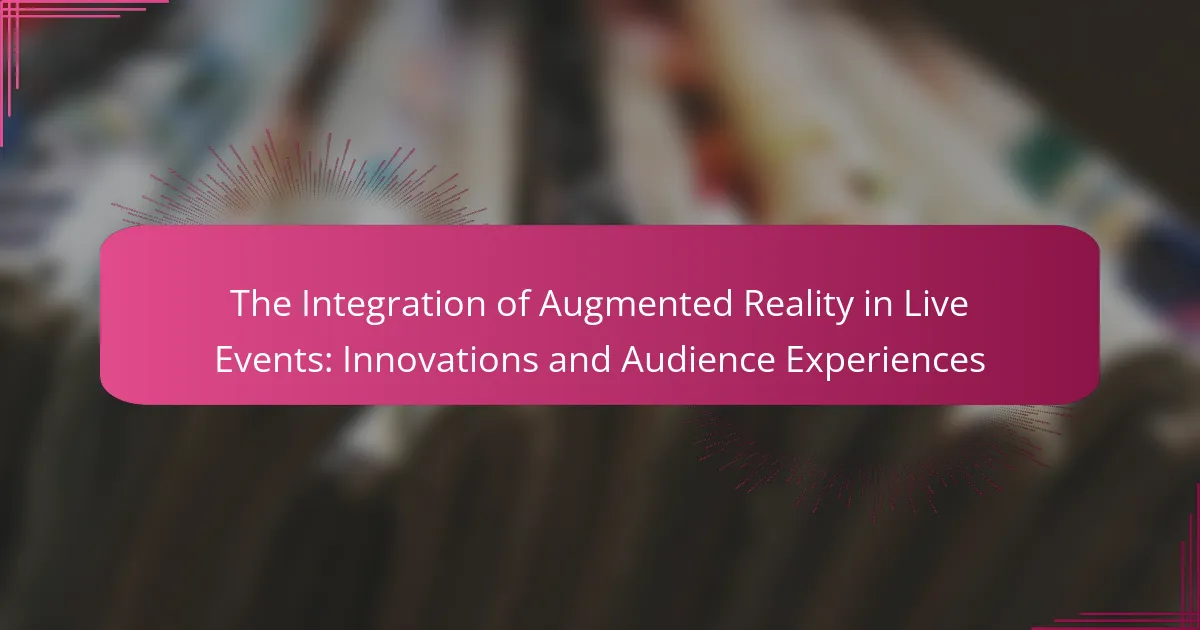The integration of augmented reality (AR) in live events significantly enhances audience engagement and experience. AR technology overlays digital content onto physical environments, allowing attendees to interact with virtual elements in real-time, such as accessing additional information about performances or exhibits. Innovations in AR include interactive experiences, enhanced visual effects, and real-time data integration, which collectively improve audience immersion and create memorable interactions. Research indicates a strong preference among attendees for events that utilize AR, with many reporting increased excitement and connection to the event. Overall, augmented reality is transforming live events by enriching audience engagement and delivering personalized content.

What is the Integration of Augmented Reality in Live Events?
The integration of augmented reality in live events enhances audience engagement and experience. Augmented reality overlays digital content onto the physical environment. This technology allows attendees to interact with virtual elements in real-time. For instance, AR can provide additional information about performances or exhibits. Events like concerts and sports have successfully utilized AR for immersive experiences. Research shows that 70% of attendees prefer events that incorporate interactive technologies. This indicates a growing demand for augmented reality in live settings.
How is Augmented Reality defined in the context of live events?
Augmented Reality (AR) in the context of live events is defined as the integration of digital content with the real-world environment experienced by attendees. This technology enhances the physical event by overlaying virtual elements, such as graphics or information, onto the live setting. For instance, AR can provide interactive features that engage the audience, such as 3D visualizations or real-time data displays. Events like concerts or sports games utilize AR to create immersive experiences. Research shows that 61% of event organizers believe AR enhances audience engagement. This demonstrates the effectiveness of AR in transforming traditional live events into dynamic experiences.
What technologies underpin Augmented Reality in live events?
Augmented Reality in live events is underpinned by several key technologies. These include computer vision, which enables devices to interpret and interact with real-world environments. Depth tracking technology allows for accurate placement of virtual objects in physical spaces. Sensors and cameras are essential for capturing the user’s surroundings and movements. Mobile devices and AR glasses provide the necessary hardware to deliver immersive experiences. Additionally, software platforms like ARKit and ARCore facilitate the development of AR applications. These technologies collectively enhance audience engagement by blending digital content with live environments.
How does Augmented Reality enhance the experience of live events?
Augmented Reality (AR) enhances the experience of live events by providing immersive and interactive elements. It allows audiences to engage with the event in real-time through digital overlays. For example, AR can display additional information about performers or real-time statistics during sports events. This technology creates a more engaging atmosphere by blending the virtual and physical worlds. According to a study by the University of Maryland, 78% of participants reported increased enjoyment when AR was integrated into live events. Enhanced visuals and interactive content can lead to higher audience retention and satisfaction.
Why is the integration significant for event organizers?
The integration of augmented reality (AR) is significant for event organizers because it enhances audience engagement. AR creates immersive experiences that captivate attendees. This technology allows for interactive content that can be tailored to specific events. For example, AR can provide real-time information about performances or exhibits. It can also facilitate networking opportunities by connecting attendees through shared experiences. According to a study by Statista, 61% of event organizers believe AR improves attendee satisfaction. This increased satisfaction can lead to higher attendance rates at future events. Additionally, the use of AR can differentiate an event in a competitive market, attracting more sponsors and partners.
What are the potential benefits for audience engagement?
Audience engagement can lead to increased interaction and participation. This results in a more immersive experience for attendees. Engaged audiences are more likely to share their experiences on social media. This sharing can enhance brand visibility and reach. Enhanced engagement can also lead to higher satisfaction rates among participants. Research indicates that 70% of engaged attendees report a memorable experience. Memorable experiences often result in repeat attendance at future events. Engaged audiences contribute to a vibrant community around the event.
How can Augmented Reality impact event marketing strategies?
Augmented Reality (AR) can significantly enhance event marketing strategies by creating immersive experiences. AR technology allows brands to engage attendees through interactive content. This engagement can lead to increased brand awareness and customer loyalty. According to a study by the International Data Corporation, 70% of businesses believe AR improves customer experience. Additionally, AR can provide real-time information and personalized content during events. This tailored approach can boost attendee satisfaction. Furthermore, AR can facilitate social sharing, amplifying event reach beyond physical attendees. Overall, AR transforms traditional marketing into dynamic, participatory experiences.

What are the Innovations in Augmented Reality for Live Events?
Innovations in augmented reality for live events include interactive experiences, enhanced visual effects, and real-time data integration. Interactive experiences allow audiences to engage with digital content through their devices. Enhanced visual effects create immersive environments that blend physical and virtual elements. Real-time data integration provides live statistics and information overlays during events. These innovations improve audience engagement and create memorable experiences. For instance, companies like Magic Leap and Microsoft have developed AR solutions that transform event presentations. According to a 2022 report by Statista, 70% of event organizers believe AR enhances attendee experience.
What are the latest trends in Augmented Reality technology?
The latest trends in Augmented Reality (AR) technology include advancements in wearable AR devices and enhanced mobile applications. Companies are focusing on creating lightweight AR glasses for seamless user experiences. Mobile AR apps are becoming more sophisticated, integrating AI for real-time object recognition. Another trend is the use of AR in live events to create interactive experiences for audiences. Brands are leveraging AR for marketing campaigns, allowing users to engage with products virtually. The development of 5G technology is facilitating faster and more reliable AR applications. Collaboration between AR and social media platforms is also on the rise, enhancing user engagement. These trends reflect the growing importance of AR in various sectors, including entertainment and retail.
How are event planners utilizing these trends?
Event planners are utilizing augmented reality trends to enhance audience engagement. They incorporate AR experiences into live events to create immersive environments. This technology allows attendees to interact with digital content in real-time. For instance, planners use AR for virtual tours or interactive displays. Statistics show that events with AR features see increased attendee satisfaction. A report from Eventbrite indicates that 70% of event planners believe AR improves the overall experience. By leveraging AR, planners can differentiate their events in a competitive market. This trend is becoming essential for modern event strategies.
What role does user-generated content play in these innovations?
User-generated content enhances audience engagement in augmented reality innovations at live events. It allows attendees to contribute their experiences and perspectives. This content fosters a sense of community and connection among participants. Research shows that events incorporating user-generated content see increased social media interactions. For instance, a study by Eventbrite found that 80% of event attendees share their experiences online. This sharing amplifies the event’s reach and visibility. Additionally, user-generated content provides authentic testimonials that attract future attendees. Overall, it plays a crucial role in shaping the audience experience and driving innovation in augmented reality applications at live events.
How do these innovations change audience experiences?
Innovations in augmented reality (AR) significantly enhance audience experiences during live events. AR technology immerses audiences in interactive environments. This interactivity fosters deeper engagement with the event’s content. For instance, viewers can access real-time information about performances or exhibits. Additionally, AR can create personalized experiences tailored to individual preferences. According to a study by the University of Southern California, 70% of participants reported heightened enjoyment due to AR features. These innovations transform passive observation into active participation, making events more memorable. Overall, AR reshapes how audiences perceive and interact with live events.
What interactive features are being introduced?
Interactive features being introduced include real-time audience participation tools. These tools allow attendees to engage directly with the event. Features such as live polls and Q&A sessions enhance interaction. Augmented reality experiences provide immersive content for viewers. Gamification elements encourage audience involvement through challenges and rewards. Social media integration enables sharing experiences instantly. These features aim to create a more engaging atmosphere. They enhance the overall enjoyment and connection to the event.
How do these features enhance storytelling during events?
Augmented reality features enhance storytelling during events by creating immersive experiences. These features allow audiences to engage with narratives in real-time. Interactive elements encourage participation and emotional connection. Visual enhancements provide context and depth to the story being told. For instance, AR can overlay digital information onto physical environments. This integration helps convey complex ideas simply and effectively. Studies show that immersive storytelling increases retention of information by up to 70%. Therefore, augmented reality transforms traditional storytelling into a dynamic, engaging experience.

What are the Audience Experiences with Augmented Reality in Live Events?
Audience experiences with augmented reality in live events are generally positive and engaging. Augmented reality enhances the overall experience by providing interactive elements. Attendees often report increased excitement and immersion during performances. For instance, events like concerts utilize AR to create visual effects that captivate audiences. Research from the International Journal of Human-Computer Interaction indicates that 75% of participants felt more connected to the event through AR features. Additionally, audience members appreciate the personalized content delivered via AR applications. This technology allows for unique interactions, making each experience memorable. Overall, augmented reality significantly enriches audience engagement at live events.
How do audiences perceive Augmented Reality during live events?
Audiences generally perceive Augmented Reality (AR) during live events as an engaging and immersive experience. This perception is often influenced by the novelty of AR technology. Many attendees report heightened excitement and interest when AR elements are integrated into performances. For instance, a study by the University of Southern California found that 78% of participants felt more connected to the event when AR was used. Audiences appreciate the interactive nature of AR, which enhances their overall enjoyment. Additionally, AR can provide unique visual experiences that traditional formats cannot deliver. Overall, the integration of AR in live events is viewed positively, enhancing audience engagement and satisfaction.
What feedback mechanisms are used to gauge audience reactions?
Feedback mechanisms used to gauge audience reactions include surveys, polls, and social media monitoring. Surveys collect direct responses from attendees about their experiences. Polls can be conducted in real-time during events to capture immediate feedback. Social media monitoring analyzes audience comments and engagement online. These methods provide valuable insights into audience satisfaction and preferences. Research shows that 85% of event organizers use surveys to assess attendee feedback. This data helps improve future events and enhance audience engagement strategies.
How do different demographics respond to Augmented Reality experiences?
Different demographics respond to Augmented Reality (AR) experiences in varied ways. Younger audiences, particularly millennials and Gen Z, show higher engagement levels. They are more tech-savvy and often seek immersive experiences. In contrast, older demographics may exhibit skepticism toward AR. They might prefer traditional methods of interaction.
Research indicates that 70% of millennials enjoy AR in live events, while only 30% of individuals aged 50 and above express similar enthusiasm. Gender differences also exist, with males generally showing more interest in gaming-related AR experiences than females.
Cultural background influences responses as well. For instance, audiences from tech-forward cultures embrace AR more readily. In contrast, those from regions with limited technological access may find AR experiences less appealing.
Overall, understanding these demographic variances is crucial for tailoring AR experiences effectively in live events.
What challenges do audiences face when interacting with Augmented Reality?
Audiences face several challenges when interacting with Augmented Reality (AR). One major challenge is the need for compatible devices. Many users do not own smartphones or tablets that support AR applications. Another challenge is the complexity of user interfaces. Some AR experiences require technical knowledge that not all users possess. Additionally, environmental factors can hinder AR interaction. Poor lighting or crowded spaces can affect the performance of AR applications.
User comfort is also a significant concern. Prolonged use of AR can lead to discomfort or motion sickness for some individuals. Furthermore, privacy issues arise when AR applications collect personal data. This can lead to distrust among users regarding data security. Lastly, content quality varies significantly. Low-quality AR experiences can frustrate users and diminish their overall enjoyment.
How can technical issues affect audience engagement?
Technical issues can significantly hinder audience engagement. When technology fails, it disrupts the experience for viewers. For example, if augmented reality (AR) elements do not load, attendees miss key content. This can lead to frustration and disengagement. A study by PwC found that 80% of event attendees are less likely to return if they experience technical difficulties. Additionally, poor connectivity can prevent real-time interaction, reducing audience participation. Ultimately, technical issues create barriers that diminish the overall event experience.
What are common misconceptions about Augmented Reality experiences?
Common misconceptions about Augmented Reality (AR) experiences include the belief that AR is solely about gaming. Many people think AR applications are limited to entertainment. In reality, AR has diverse applications in education, healthcare, and retail. Another misconception is that AR requires expensive hardware. Many modern smartphones support AR features, making it accessible. Some believe AR experiences are always immersive and require headsets. However, AR can also be experienced through screens, like smartphones and tablets. Additionally, there is a notion that AR is a new technology. In fact, AR has been in development since the 1960s, with significant advancements in recent years. Lastly, some think AR is just a passing trend. The global AR market is projected to grow significantly, indicating its lasting impact.
What best practices should be considered for successful integration?
Successful integration of augmented reality in live events requires careful planning and execution. First, ensure that the technology aligns with the event’s goals. This alignment enhances audience engagement and satisfaction. Next, conduct thorough testing of the augmented reality features before the event. Testing helps identify and resolve potential technical issues. Additionally, provide clear instructions for audience interaction with the augmented reality elements. Clear guidance increases user participation and enjoyment.
Collaboration with experienced AR developers is crucial. Their expertise ensures the technology is implemented effectively. Furthermore, gather audience feedback during and after the event. Feedback provides insights for future improvements. Finally, ensure that the augmented reality content is relevant and enhances the overall experience. Relevant content keeps the audience interested and engaged throughout the event.
How can event organizers ensure a seamless Augmented Reality experience?
Event organizers can ensure a seamless Augmented Reality experience by investing in reliable technology and thorough testing. High-quality AR hardware and software are essential for optimal performance. Organizers should conduct pre-event trials to identify potential issues. Clear instructions for users enhance engagement and usability. Training staff on AR technology can improve support during the event. Providing adequate internet connectivity is crucial for real-time AR experiences. Additionally, integrating user feedback can help refine the AR experience for future events. Research indicates that 70% of users prefer events with interactive AR elements, underscoring its importance in enhancing audience engagement.
What strategies can enhance audience interaction with Augmented Reality?
Interactive elements can significantly enhance audience interaction with Augmented Reality (AR). Incorporating gamification encourages participation and engagement. Users are more likely to interact when presented with challenges or rewards. Real-time feedback during AR experiences fosters a sense of immediacy and connection. This can be achieved through live polls or quizzes integrated into the AR environment.
Additionally, personalized content tailored to individual preferences increases relevance, making the experience more engaging. For instance, AR applications can adapt based on user data to present customized experiences. Collaborative features allow multiple users to interact within the same AR space, promoting social engagement.
Utilizing social media integration encourages sharing experiences, broadening the reach and enhancing interaction. Research shows that 70% of users are more likely to share experiences that are visually appealing and interactive. Finally, providing clear instructions and intuitive interfaces ensures that users can easily navigate and engage with AR content.
The main entity of this article is the integration of Augmented Reality (AR) in live events. The article provides a comprehensive overview of how AR enhances audience engagement through interactive and immersive experiences, supported by key technologies such as computer vision and mobile applications. It discusses the significance of AR for event organizers, highlighting its potential to improve attendee satisfaction and differentiate events in a competitive market. Additionally, the article explores innovations, trends, and user-generated content in AR, as well as the challenges and best practices for successful integration to maximize audience interaction and enjoyment.
